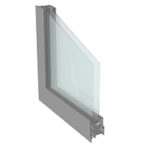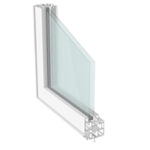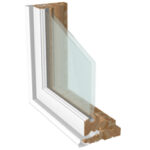Window Frames play an important role in energy efficiency and home comfort. It’s easy to pick the right ones for you.
Before I started working with the Efficient Windows Collaborative, I thought I knew about window frames – the straight stuff between the windows and the walls, holding things in place and helping me slide windows open and closed. And that’s true. But there’s a bit more to know.
What are window frames? First, let me just frame the issue here (sorry, I had to!). Window frames hold the glass in place, of course, but in efficient windows, they do more. Frames help to reduce energy use and compensate for temperature changes inside your house that could cause condensation or reduce comfort. That’s why the energy-efficiency ratings provided by our parent organization, the National Fenestration Ratings Council, include frames. They don’t just test the glass. This is one of the main reasons why NFRC ratings are a mandatory step for any window manufacturer to receive the ENERGY STAR® certification for their efficient windows.
There are multiple types of window frames available, and the key difference is the material: wood, vinyl (also known as PVC or UPVC), aluminum, steel, and fiberglass are common choices. Here’s your pocket guide to their strengths and weaknesses:

Aluminum frames are light, strong, durable, and easy to maintain. They also are among the least expensive options. But heat or cold passes through them easily, creating drafts in the winter, or unwanted heat in summer. They can be efficient if they have something sandwiched between their interior and exterior surfaces to block unwanted hot or cold air. Just make sure the window frame has this “thermal break,” and you’ll be protected from extreme temperatures, moisture, mold, and mildew.

Wood frames are energy efficient because wood is dense. Wood is widely available, inexpensive, easily formed into the shapes necessary, and can be painted whatever color you wish. However, they do need a bit of maintenance to avoid rotting and warping.

Vinyl frames are as efficient as wood frames and require no maintenance. Newer versions also protect against sun damage and can be painted. Vinyl frames are moderately expensive depending on operator type and glass package, among other factors.

Composite frames mimic wood’s appearance but resist moisture and are more durable. They are combinations of wood and plastic, often using recycled materials. They are also efficient and can be painted any color. These frames, on average, tend to be more expensive.

Hybrid frames combine multiple materials in one window-frame design. Wood-clad frames are a common type of hybrid with wood on the interior for aesthetics, and aluminum on the exterior for durability, for example. You might hear window salespeople call them split-sash frames. These are often more costly than other frames.
Whatever you choose, the important thing to remember is that you can’t go wrong if you pay attention to the NFRC label on the glass and the ratings it shows you. You can learn more about the label and ratings on this page of our site, and more about frames here. Pick the best windows for your home and climate using the Window Selection Tool.
